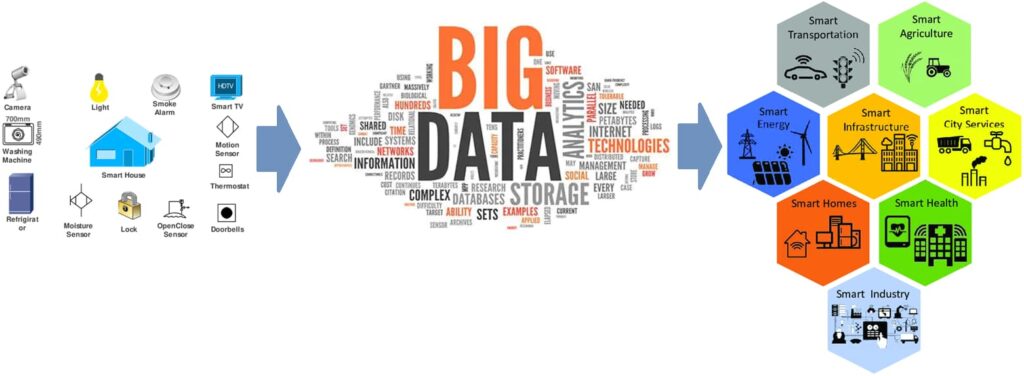The Role of Big Data in Smart Cities
Cities are growing fast and more people moving there every year. This growth provides problems like traffic jams, pollution and managing basic services. Many cities use technology to solve them. Big Data helps a lot in this effort – cities can better allocate resources and make life better for everyone. This article will discuss how Big Data enhances urban living.
Big Data and Urban Planning
Urban planning once depended on surveys, maps and manual data collection. This process took a lot of time and sometimes gave old information. Big Data changes how cities plan by providing data from sensors, social media and traffic cameras in real-time.
City planners make wiser decisions with accurate information. Traffic data shows problem areas that need work. When planners know where congestion happens most often they focus on those spots. This targeted approach saves time and avoids useless efforts.
Big Data helps make air quality monitoring better. Sensors all around the city show pollution levels at different times. This info helps cities identify places with high pollution. They can then take steps to reduce it. Public safety gets a boost too. Emergency services get real-time updates about incidents – faster responses save lives and property.
Also, services like online live casino sites have changed entertainment for city residents. People enjoy games online, reducing the need for physical casinos. This shift impacts urban planning by allowing planners to focus on other areas.
Utilities like water and electricity use Big Data to manage resources better. They look at how people use these services and see when there is the most demand. This helps cities give out resources in a smart way and stops systems from becoming too busy.
Waste management also gets better with Big Data. Cities learn which areas produce more waste. They then adjust pick-up schedules, making fewer trips and saving money.
Key Components of Smart Cities
Smart cities use technology to improve various aspects of urban life. It improves efficiency, safety and quality of life for residents. Several key components are at the foundation:
- Sensors and IoT devices. Sensors gather data on air quality, water usage and more. Internet of Things (IoT) devices connect these sensors to central systems for data collection.
- Data analytics. Large volumes of data require analysis to extract useful information. Analytics tools help cities understand patterns and trends.
- Smart infrastructure. Modern infrastructure adapts and responds to changing conditions. Examples include smart grids for electricity that adjust supply based on demand and intelligent traffic lights that reduce congestion.
- Communication networks. Reliable communication networks allow data transfer between devices and central systems. 5G networks provide faster and more reliable connections.
- Government services. Online platforms streamline permits, applications and services like healthcare and education. This makes public services more accessible to everyone.
- Public safety systems. Surveillance cameras, emergency alert systems and real-time crime mapping tools improve security.
Each of these components functions independently but works better when integrated into a cohesive system. Smart cities do not just adopt technology; they embed it into daily life to solve problems and improve living conditions for all residents.
Challenges and Solutions
Big Data helps cities in many ways but also brings problems. One big problem is keeping personal data private. Many People worry about safety and use of that info. So cities should follow strict rules and use strong measures to protect everyone’s info.
Another problem is mixing different types of data. Cities get information from places like sensors and public records. Different formats make it hard to combine all this data. Common standards help with this issue. Special tools for mixing data also provide solutions.
Limited money makes things tough as well. High-tech tools and skilled workers cost a lot. Cities find it tough to keep spending low. Teaming up with private firms and seeking grants can cut costs. Public and private groups can share resources for everyone’s gain.
People might not like or trust new technology. To win them over, cities should talk openly to their residents. Clear talks about the help new systems bring and direct answers to worries can ease doubts.
Future Trends
Future trends in smart cities aim for better-connected and more advanced urban areas. New technologies open up ways to make life better. Here are some key trends:
- Autonomous vehicles. Self-driving cars and buses help cut traffic accidents and make public transport run better.
- Renewable energy sources. Solar panels and biodegradable materials provide infrastructures with sustainable power.
- Blockchain. It allows secure data exchange. This improves transparency and reduces fraud in government operations.
- AI-assisted healthcare. Machine learning algorithms help diagnose diseases quickly and offer improved treatment plans.
- Augmented reality. AR apps guide tourists and residents. They offer information on historical sites and navigation tips.
Final Words
Big Data changes how cities work. It helps improve resource use and public safety. City planners can use live data to fix traffic jams and cut pollution. Sensors check air quality and spot problem areas. Utilities look at usage patterns to provide services better.

























Leave a Reply